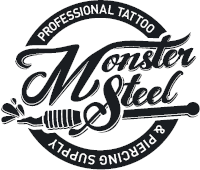Getting the right tattoo needle size is a critical part of the process and somewhat a bit confusing for someone just starting out and not familiar with each type of needle and why and how to use them.
It’s not an easy task given the variability between manufacturers and the lack of standardized sizing across industry. Just as in everything else in life, knowledge is power. Taking the mystery out of choosing a tattoo needle will make the whole process easier and less stressful.
Tattoo terms you need to be sure to understand:
- Taper
- Liner vs. shader needles
- Count and diameter
- Configuration variations
Once you understand these fundamentals, you’ll be able to choose the perfect needle for any style of tattoo.
Choosing tattoo needle taper
The length of the point of the needle is the taper and there is a wide range of variety between manufacturers here. You’ll find tapers from 1.5 millimeters all the way up to 7 millimeters (though those are pretty hard to find).
Why is taper important? The lower the taper length, the more ink flows into the skin at once. A higher taper measurement means that ink flows more slowly into the skin. That makes those higher tapers great for working with black and gray colors as you have more time to work with the skin before the color completely fills in.
For the most part, choosing taper size is a point of personal preference. There are plenty of tattoo artists out there who don’t think that there’s a great deal of difference in taper sizes, so in truth this might not be a big deal to you. If you’re not sure, go with a medium taper that won’t entail any tightening. Like most of the whole process of choosing a tattoo needle, preference comes with experience.
Choosing a tattoo needle type
There’s not just one kind of needle, there are many varieties, each with their own purpose, strengths and weaknesses. Let’s break it down. Each needle is actually made up of lots of little needles, bound together in various shapes and with varying levels of tightness.
Liners are perfect for detailed work that’s highly intricate. Liners are almost always needle groups that are soldered together tightly. All of that accenting, vibrant coloring, text, scripting and tremendous detail that clients want come with using a liner needle.
Shaders are for filling in larger areas, and generally come with several needles in a looser grouping. though shaped in the form of a pentagon. There are many configurations that come in sets of three, five, seve, nine and as large as 30 needles grouped together. Mags and flats tend to be bigger and work well to cover larger areas of the skin.
- Round Shader (or loose needles) - Abbreviations: RS
Though there’s a lot of versatility with rounds, they work mostly as shaders and for forming circles. There are two different kinds of rounds – shaders and liners.
- Magnums (or mags) – Abbreviations: mag, M1, M1C, M2
These can come straight or curved, in one or two rows. For filling in a large area that only needs to be of a single color, a regular rather than a double-stacked magnum is a perfect choice. You’ll find that color is distributed beautifully with a regular magnum.
- Round Liner Needles (Tight) – Abbreviations: RL, RLXT, RLXP,
These needles are more tightly bound together than round shaders, and are used to get crisp, strong lines.
- Flats – Abbreviations: FS, F
Flats work well to distribute color and they do a beautiful job of giving a depth to one tone color. The needles are arranged side-by-side in a row (they’re flat!).
Choosing count and diameter in tattoo needles
These aspects of tattoo needle sizing are much simpler than they appear. Count is the number of needles that that are included in the needle. Diameter is how wide those needles are when packed together around a central bar.
Here's an example of four needle diameters:
- Size 6 = .2 millimeters
- Size 8 = .25 millimeters
- Size 10 = .30 millimeters
- Size 12 = .35 millimeters
The higher the diameter, the thicker the tattoo needle and the more area it will fill at one time. Smaller is better for tighter lines, bigger means more effective and faster shading. Of these, size ten is the most commonly used.
Quick cheats for choosing tattoo needle sizes
Choosing the size of a needle is all about what kind of tattoo you’re doing.
- Round and low for lining small tattoos.
- Thick lines, large canvas designs (think back work), or shading, you’ll want a needle that’s more round.
- Mags are versatile and are the best thing for working with color.
- Curved Mags are great for portraits and highly detailed color work.
- Round liners are for detailed lines & smaller tattoos requiring fewer needles.
- Flat shaders give unique blending marks, “whip strokes”
Determining what needle size you need to use is a process, it’s not something you can just sit down and check off a list like you’re picking up toilet paper at the superstore.
Think about the tattoo that you’re going to do, visualize it before you think about the needles that you’re going to use. Think about the colors, the outlines, script, the boldness, the shading and the thickness, then move toward looking at which needles will fit the bill.
Start off with commonly used and versatile needles, then expand your repertoire and learn more about exactly what kinds of needles are most effective for various kinds of designs. Go you’re your gut, and use your intuition, especially as you get more comfortable and knowledgeable. Tattooing is, after all, an art form.

